Higbee Beach. The 2nd Avenue Jetty. The Beanery. The Meadows. Hidden Valley. The Hawkwatch Platform. Any birder who has ever visited Cape May and many who have not will recognize these place names that are iconic in the birding world. All of them were on the route of the Triathlon Hawks, our Swarovski Optik-sponsored team competing in the Carbon Footprint category of the 2011 World Series of Birding. Though, considering our choice to spend a huge hunk of time in kayaks, participating might be a better word then competing, but we knew that going in to the event, and, despite our finishing well back of the winners of the category* we had an absolute blast and really enjoyed our day birding the legendary environs of Cape May County.
Before I go further I should, of course, introduce my two teammates who suffered with me the torments of hours on 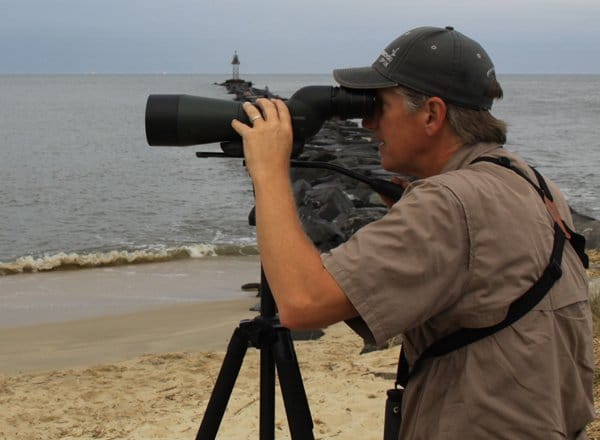 bicycle seats and hard plastic kayaks. Clay Taylor will be a familiar name to anyone who spends time at birding festivals because he is the staff birder at Swarovski Optik North America. I am sure he has a more official title but, essentially, it is his job to show off the marvelous optics that Swarovski Optik creates to crowds of admiring birders. Not a bad gig if you can get it. Clay was the driving force behind the Triathlon Hawks and put the whole weekend together. Brian Bielfelt is a birding biologist who has birded and lived all over the United States but currently calls Texas home. He knows his stuff and, with the exception of the occasional Red-winged Blackbird call, is rarely fooled by a bird. The three of us combined were
bicycle seats and hard plastic kayaks. Clay Taylor will be a familiar name to anyone who spends time at birding festivals because he is the staff birder at Swarovski Optik North America. I am sure he has a more official title but, essentially, it is his job to show off the marvelous optics that Swarovski Optik creates to crowds of admiring birders. Not a bad gig if you can get it. Clay was the driving force behind the Triathlon Hawks and put the whole weekend together. Brian Bielfelt is a birding biologist who has birded and lived all over the United States but currently calls Texas home. He knows his stuff and, with the exception of the occasional Red-winged Blackbird call, is rarely fooled by a bird. The three of us combined were a disaster waiting to happen a force to be reckoned with!
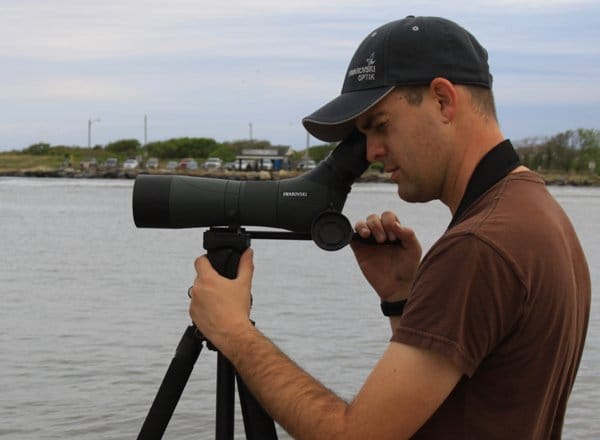 Our birding day started at shortly before 5 AM** at The Meadows, the famed Nature Conservancy property adjacent to Cape May Point State Park, where we did not hear rails but we did hear birds like Canada Goose and Tree Swallow. Nearly despondent at our rail dip we walked back to the parking lot, strapped on our headlamps, climbed on our bicycles, and started pedaling, only to be brought up short by a calling Sora! Sweet!
Our birding day started at shortly before 5 AM** at The Meadows, the famed Nature Conservancy property adjacent to Cape May Point State Park, where we did not hear rails but we did hear birds like Canada Goose and Tree Swallow. Nearly despondent at our rail dip we walked back to the parking lot, strapped on our headlamps, climbed on our bicycles, and started pedaling, only to be brought up short by a calling Sora! Sweet!
With one rail in the bag we headed north to Higbee Beach with the hope of finding Neotropical migrants galore. En route I was nearly decapitated by a Common Nighthawk that made me think that maybe a helmet would have been a good idea after all but, fortunately for both me and the nighthawk, it swerved off just in time, leaving me to say, like Keanu Reeves in The Matrix, “Whoa.” I’m just glad that Clay and Brian were paying attention and also saw the bird because my failure to let them know that a Common Nighthawk was hurtling at my head at high speed is really unforgivable.
Higbee Beach was where our big day dreams died. We found a total of five species of wood-warbler, no thrushes, one vireo, no tanagers, and Clay’s bike’s front tire found a thorn, though we would not be made aware of that until later. Sure, a singing Blue Grosbeak was nice for this New Yorker to hear, as was a singing Yellow-breasted Chat, but we needed far more birds to have a really big day and once we realized that the migrants were not in southern Cape May County we could give up hopes of having a monster of a day and just bird and enjoy it.
looking east on the Cape May Canal
The jetty by the western terminus of the Cape May Canal held not only our hoped-for Purple Sandpipers but also a Sanderling and a couple of Ruddy Turnstones, a nice trio of shorebirds. Clay picked out a distant Common Loon flying by, our only loon of the entire day, and a couple of Northern Gannets made an appearance as well. A stop at Hidden Valley netted us several species, including our only Scarlet Tanager of the day as well as a surprise fly-by adult Bald Eagle.
Brian getting ready to lock up the bike at The Beanery
A couple of side roads where we investigated some small ponds did not net us anything but a singing Red-eyed Vireo, which was, surprisingly, our only one of the day. Next we stopped by The Beanery where an extremely distant singing Veery at the limits of the human ear was the only new bird to grace our list. It was nice to see Prothonotary Warbler nest boxes but it would have been nicer to see a Prothonotary Warbler. A stop back at The Meadows got us some more common birds and a scan of the ocean added two scoter species as well as several Parasitic Jaegers harassing terns, easily the best bird of the day, at least for me. They were close to shore and awesome.
Back in the parking lot we met up with a pair of videographers doing a video to promote tourism in New Jersey. They followed us to our next couple of stops filming nonstop and interviewed Clay. The irony of me possibly appearing in tourism materials for New Jersey is overwhelming and could only be matched by a move to Staten Island (NOT HAPPENING!).
DEATH!
We did add Northern Waterthrush, Northern Parula, and several more species as we peddled to the Cape May Bird Observatory and over to Cape May Point State Park but then disaster struck in the form of that thorn in Clay’s tire which had causes a slow leak that left his tire dangerously low. A solution was needed, and it consisted of a rapid return to the bike rental shop, which meant missing the jetties at a lower tide, and because we had gone completely out of our way we needed to do the kayak section early, also at a lower tide. We wanted to do the jetties at a low tide because at high tide they are covered and do not host birds while we wanted to do the kayaking at a high tide when shorebirds are concentrated instead of spread out on exposed mudflats. This probably cost us birds. How many?
You’ll have to come back for part two of this tale soon to find out! Also, you’ll want to hear about disaster in the saltmarsh, a delicious lunch, and birds birds birds!
*The aptly named Anti-Petrels of the Cornell Lab of Ornithology.
**See! We knew we were not going to be in the running so we slept in. Teams who want to win start at the stroke of midnight!
…


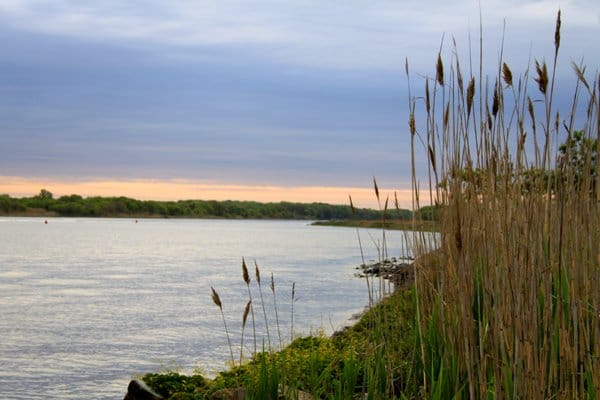
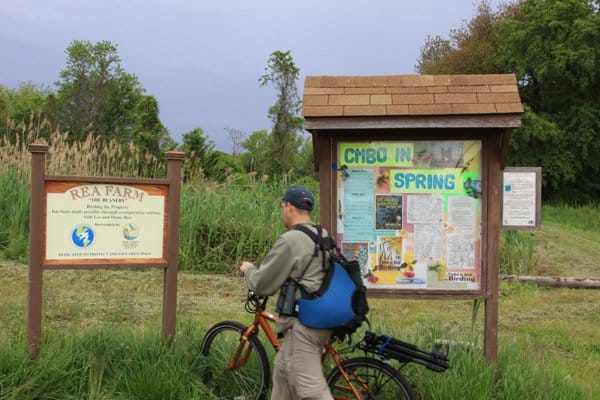
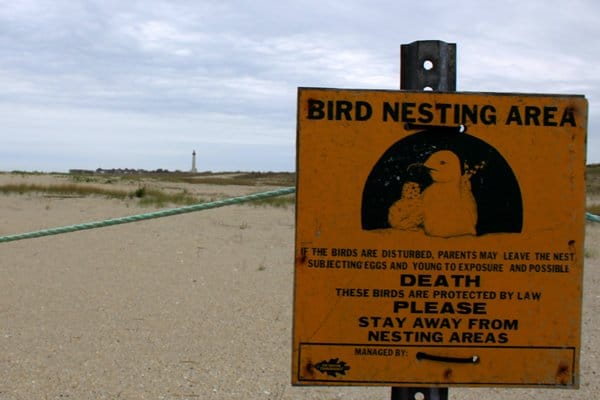



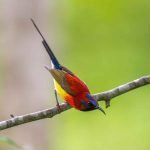
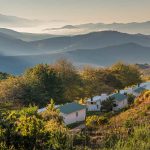
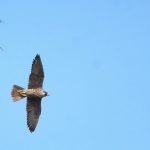
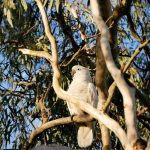
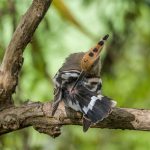
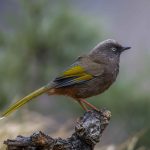

I’m intrigued.
I haven’t seen that sign. It might be better if they put something other than a gull on it.
I like the concept of a birding triathlon very much.
DEATH!!! (Said like Abe Simpson)
So for how many days did your ass hurt from the bike riding?
The Death sign is stupid. In Germany, those parts of the forest wthat have breeding eagles are closed to the public. But on the signs along the forest roads and tracks, it doesn’t say “Breeding Area for Eagles, who may find DEATH if you disturb them”.
The signs say “Area with high viper concentrations. DEATH may find YOU if you disturb them”.
Works very well.
@Patrick: Surprisingly it was ok…